How Much Land Do I Need for a Grass Feed Cattle Farm
Cows are large animals, so is raising them on a small scale really practical? Our answer – YES! We'll break down the factors surrounding the question of, "How many cows per acre?" and share how we raise cows on our 5-acre farm.
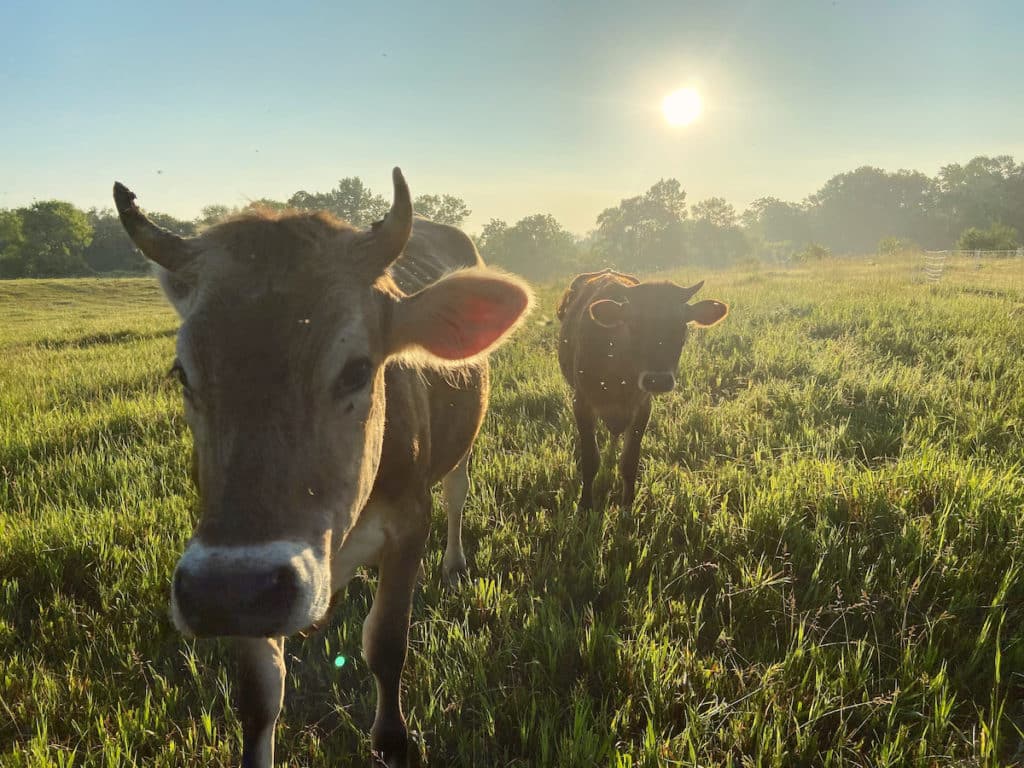
General Rules of Thumb
The general rule of thumb is 1:1. That means one cow per one acre of pasture. Keep in mind that is a minimum requirement. A cow/calf pair will typically require closer to two acres.
The daily utilization rate for livestock is also commonly referenced. That number is 4%, meaning livestock need to intake 4% of their body weight daily.

Both of these rules of thumb are helpful to reference when considering how many cows per acre. But, they should not be taken as absolutes. Many factors around your management, your cows, and your land will influence the stocking rate (number of cows) on your land.
Management Factors
What will they eat?
A cow's natural diet is grass. Grains are commonly supplemented or substituted. 100% grass-fed cows will obviously require more pasture than cows being fed 100% grain or a combination.
For the purposes of this post, we will assume we are talking about 100% grass-fed cows. This is the healthiest option for the cow, environment, and end consumer.
Grazing method
A common grazing method on a small scale is to simply have one, or a couple, larger paddocks the cows have access to graze in. This method does not require much management. However, you run the risk of overgrazing. The quality of pasture will also likely degrade over time since grasses won't have necessary recovery times.
Rotational grazing is another option. This method uses smaller paddocks to systematically move your herd around your pasture. Cows are typically only on a section of pasture a day or two to prevent overgrazing and not brought back to that same section until it is fully regrown. The benefit is higher quality pasture for your cows. It also keeps your pasture healthy long-term. The downside is that rotational grazing can take significant time and management.
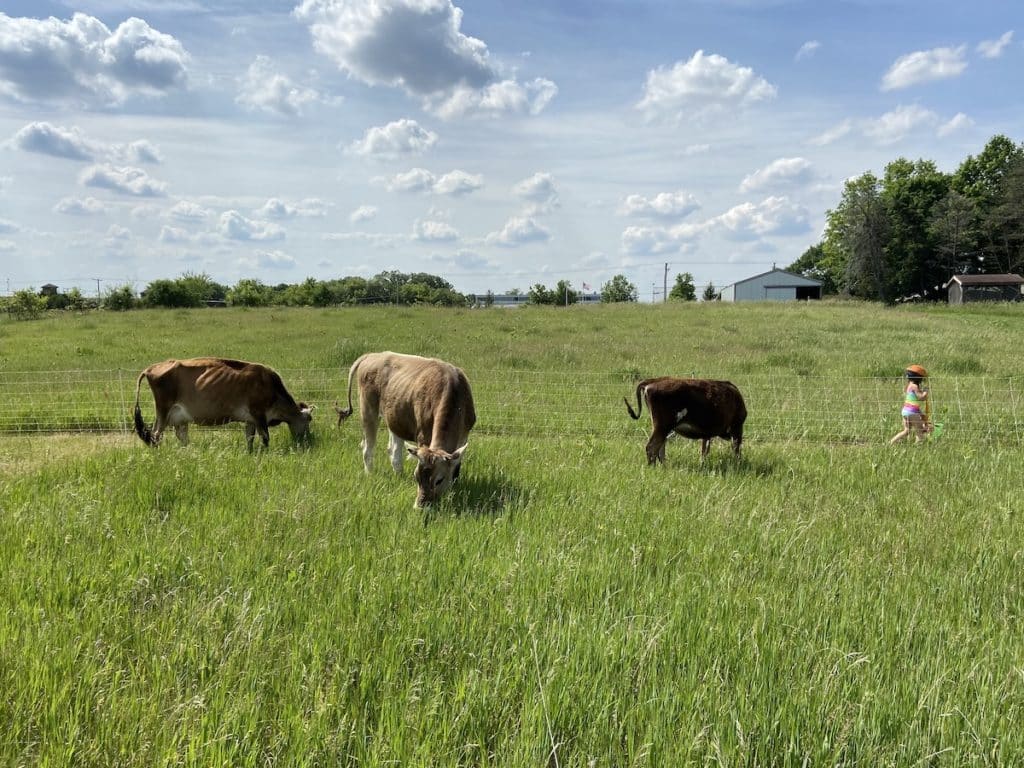
Are there other animals grazing?
There can be many benefits to multi-species grazing. Sheep and goats, for instance, will graze and forage differently than a cow. Incorporating other ruminants like these can help to maximize your pasture. But again, it will impact how many animals you can have per acre.
For sheep, the general rule of thumb is 7 sheep per acre. For goats, it is 10 goats per acre. If other animals are being raised alongside your cows, this will need to be factored in.
Cow Factors
Size
A 1,400 lb. cow will have significantly higher intake needs than an 800 lb. cow. This is where the 1 cow per acre rule of thumb breaks down. Smaller cattle are likely better suited for a smaller scale farm or homestead than larger.
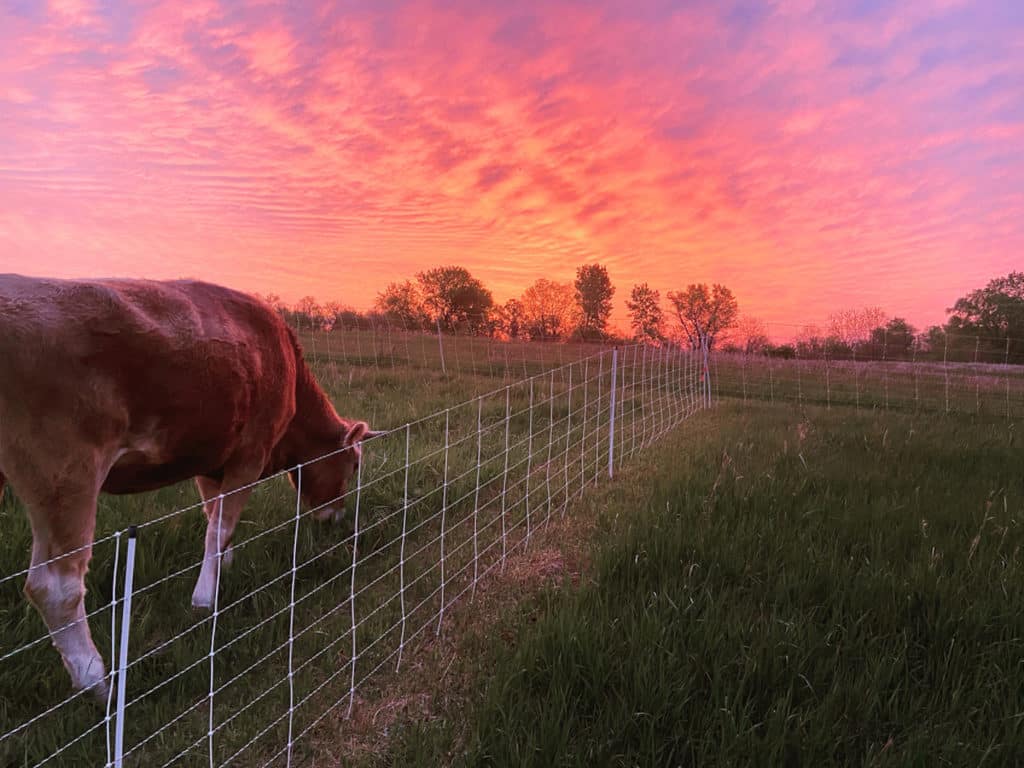
Breed
Different breeds will convert their food to weight and energy at different rates. For instance, Angus cattle have larger intake requirements due to their higher muscle mass. Smaller breeds like Dexter cattle are known to consume less.
Dairy
Dairy cattle breeds are also known for needing to consume higher quantities to account for the energy requirements needed to produce milk. Lactating dairy cattle are often said to need 2 acres of land per cow. You can learn more about our simple way we raise a Jersey milk cow and her calves in our post, Family Milk Cow Basics.
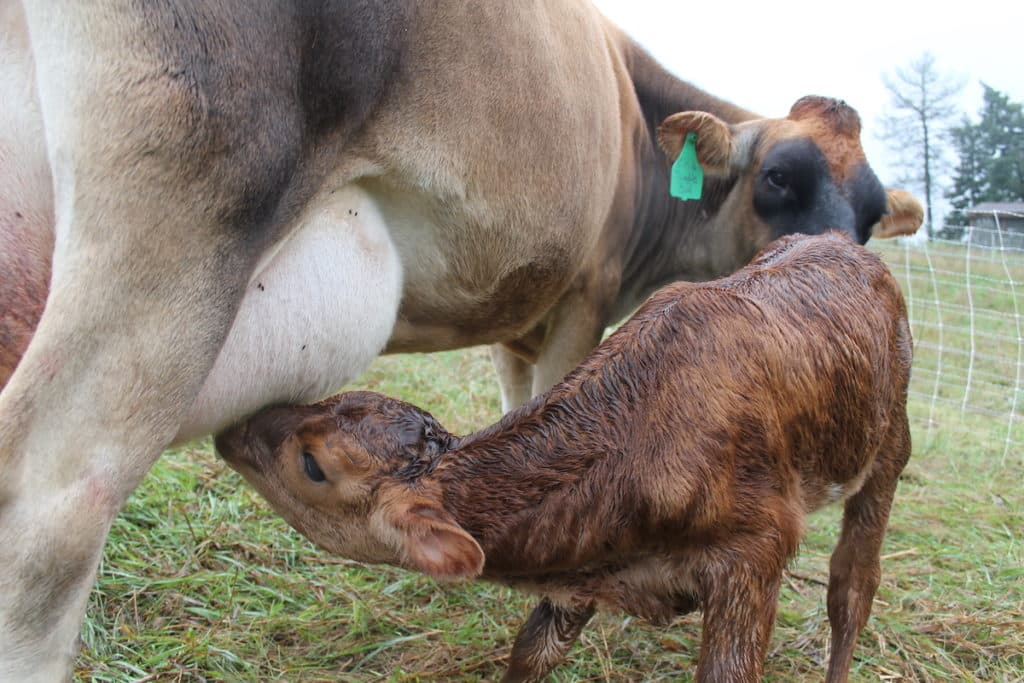
Are they pregnant?
Growing a baby requires a lot of energy and nutritional support. If your cow is growing a calf, her intake needs will be higher than normal. If raising the calf, you will also need to consider the added pasture requirement for the calf as they transition from milk to eating grass.
Land Factors
Pasture Quality
The quality of your pasture will affect how many cows you can have per acre. To give your cows a more complete nutritional profile, selection and diversity of plant life in your pasture matter. For instance, Alfalfa, Rye Grass, and Bermudagrass are higher energy grass options than others. Soil quality and density of your pasture will also impact the overall quality of your pasture and much forage your cows have available. This basic pasture inventory calculator can help estimate how much forage is available in your pasture.
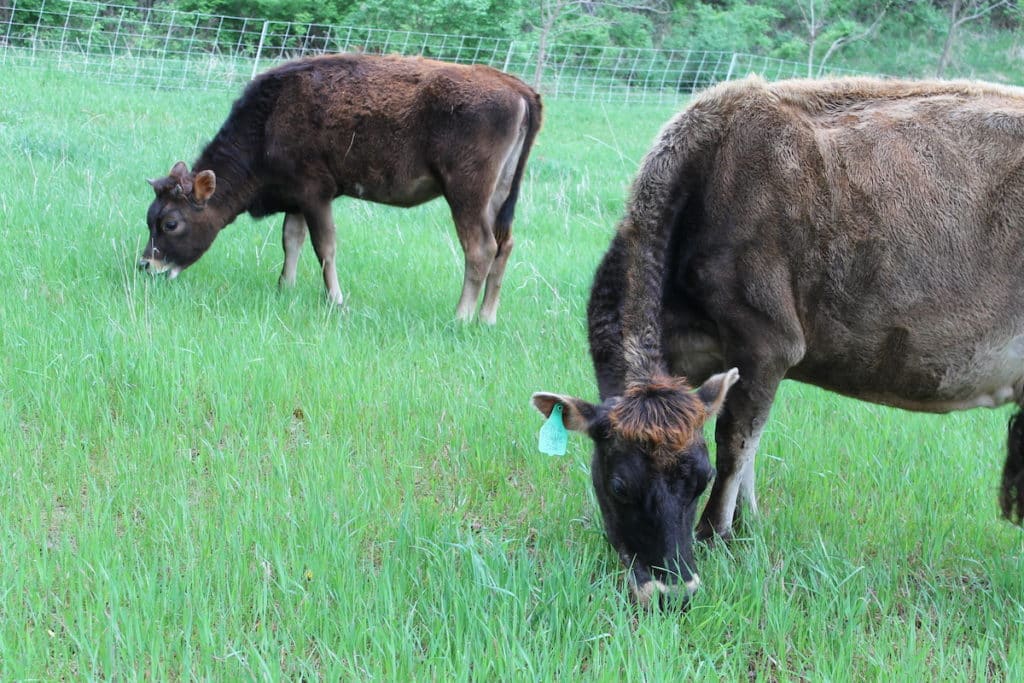
Land Makeup
You may have several acres of straight up pasture. But you may also have some woods, water features, steep grades, pole buildings, or other features on your land that impact the grazing capacity. When figuring how many cows your land can support, you will want to consider the full profile of your land and how much total pasture your cows will have available to them. For instance, wooded areas will provide some forage, but it will not equate to what a healthy pasture will provide.
Location
Your growing zone will affect the number of days your cows can be out on pasture. Northern climates will have less days for grazing than southern climates. Your growing zone will also determine your non-growing season or winter when your cows will be off pasture. Unless you have additional acres designated for cutting hay, you will need to budget for purchasing hay for your animals through the winter. We live in zone 5 and typically give our cows hay November through April.
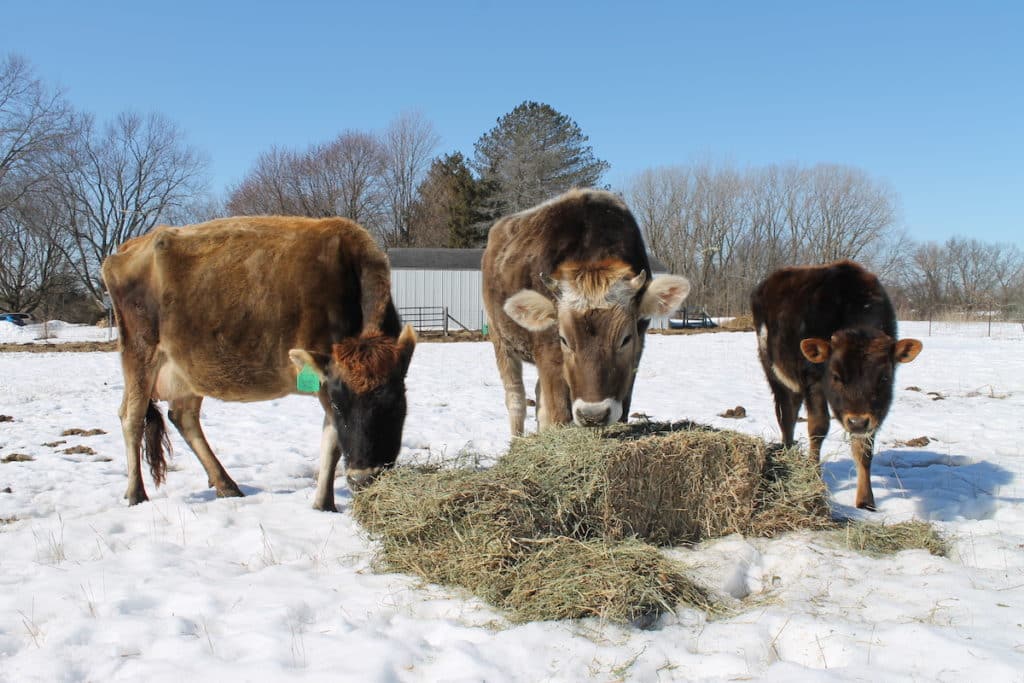
Risks of having too many cows per acre
Pasture requires a minimum of 30 days to recover before it is ready to be grazed again. Often times, more like 40-50 days are required for a full recovery. Too many cows will likely mean your pasture will not have adequate time to regrow between grazing sessions. This will deplete your pasture and soil over time and diminish the quality of your pasture. It can also mean a buildup of too much manure which can smother pasture or create concentrations of nutrients that are too high for your pasture to grow optimally.
Ideas to maximize grazing on a small scale
On our homestead, we have 5 acres total with a 3.5 acre pasture and a .5 acre permanently fenced paddock. We have a family milk cow and, depending on the season, either one or two of her calves along with her. The cows are in the permanently fenced pasture over the winter and we begin rotationally grazing them in the back field typically in May.
Rotational Grazing
Utilizing rotational grazing is the number one way to maximize your pasture. This involves creating small paddocks with temporary fencing that your cows will only spend 1-2 days in. The key is managing the system closely enough to give the pasture enough time to recover fully before it is grazed again. When managed properly, (1) your cows are getting peak forage and nutrition, (2) they will also be adding nutrients back to the soil through their manure, and (3) their efficient grazing will be actively assisting in the regrowth cycle necessary for grasses to flourish.
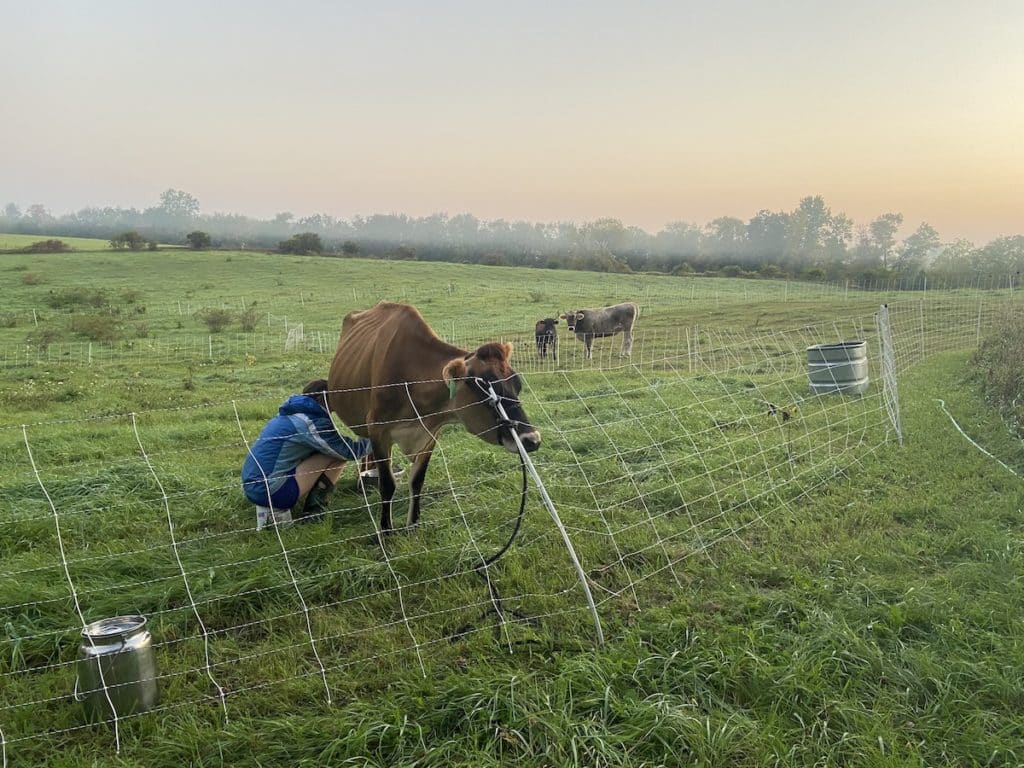
Temporary Fencing
A portable fencing system allows you to be very adaptable and efficient with your fencing. We have several sections of electro-netting fence with a solar fence energizer. We can literally set this up anywhere on our property.
For example, we have a young orchard area that is typically fenced off so the cows don't destroy our trees. However, I am able to set up the electro-netting in the grassed alleys between the rows of trees. The trees are protected and the cows get extra forage.
Utilize ALL Your Land
There are ways to think creatively about grazing your cows or animals. Our home sits on roughly 1 acre with mostly grass surrounding it. Typically, this area had been off-limits to the cows. However, this past spring the back pasture was late to begin growing. So, we set up our moveable fencing in our front yard to buy the back pasture more time. This was a win-win because the cows got extra forage and I didn't have to mow 😊
Start Small and Know Your Land
There is no one-size-fits-all approach to how many acres are needed for a cow. The factors we've mentioned are unique to your cows and land, and how you manage all of it.
Consider starting below what you calculate or think your land can handle and build your herd size from there. After a season or two of observing – how quickly your pasture recovers, how much your animals consume, how your systems work and what can be improved – you will have a much better idea of what is appropriate for your unique situation.
Overstocking too soon can lead to the quality of your pasture being continually degraded. Or, it may also mean significant and unanticipated cost to supplement your cows with hay or other feed throughout the growing season.
Start small, learn from your animals and land, and work your way into the right ratio of how many cows per acre your setup can support.
Source: https://fromscratchfarmstead.com/how-many-cows-per-acre/
0 Response to "How Much Land Do I Need for a Grass Feed Cattle Farm"
Postar um comentário